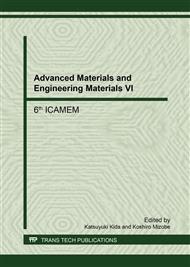[1]
M. Benwadih, J. A. Chroboczek, G. Ghibaudo, et al., Non-Arrhenius conduction due to the interface-trap-induced disorder in X-doped amorphous In-X-Zn oxides thin-film transistors, J. Appl. Phy. 117 (2015) 055707.
DOI: 10.1063/1.4907681
Google Scholar
[2]
L. Qiang and R. Yao, A New Definition of the Threshold Voltage for Amorphous InGaZnO Thin-Film Transistors, IEEE T. Elec. Dev., 61 (2014) 2394-2397.
DOI: 10.1109/ted.2014.2322075
Google Scholar
[3]
C. W. Zhong, H. C. Lin, K. C. Liu, et al., Improving Electrical Performances of -Type SnO Thin-Film Transistors Using Double-Gated Structure, IEEE Electr. Dev.L., 36(2015) 1053-1055.
DOI: 10.1109/led.2015.2465144
Google Scholar
[4]
H. Luo, L. Y. Liang, Q. Liu, et al., Magnetron-Sputtered SnO Thin Films for p-Type and Ambipolar TFT Applications, Ecs J. Sol. Stat. & Tec. 3 (2014) Q3091-Q3094.
DOI: 10.1149/2.017409jss
Google Scholar
[5]
P. C. Hsu, W. C. Chen, Y. T. Tsai, et al., Fabrication of p-Type SnO Thin-Film Transistors by Sputtering with Practical Metal Electrodes, Japan. J. Appl. Phy. 52 (2013) 492-494.
Google Scholar
[6]
M. K. Hota, J. A. Caraveo-Frescas, M. A. Mclachlan, et al., Electroforming-free resistive switching memory effect in transparent p-type tin monoxide, Appl. Phy. Lett. 104(2014) 152104-152104-4.
DOI: 10.1063/1.4870405
Google Scholar
[7]
Y. Ogo, H. Hiramatsu, K. Nomura, et al., Tin monoxide as an s-orbital-based p-type oxide semiconductor: Electronic structures and TFT application, Phys. Stat. Soli. 206(2009) 2187–2191.
DOI: 10.1002/pssa.200881792
Google Scholar
[8]
B. Kumar, H. Gong and R. Akkipeddi, High mobility undoped amorphous indium zinc oxide transparent thin films, J. Appl. ied Phy. 98(2005) 073703-073703-5.
DOI: 10.1063/1.2060957
Google Scholar
[9]
T. Kamiya, K. Nomura H. Hosono, Electronic Structures Above Mobility Edges in Crystalline and Amorphous In-Ga-Zn-O: Percolation Conduction Examined by Analytical Model, J. Disp. Tec. 5(2009) 462-467.
DOI: 10.1109/jdt.2009.2022064
Google Scholar
[10]
H. Kawazoe, M. Yasukawa, H. Hyodo, et al., P-Type Electrical Conduction in Transparent Thin Film of CuAlO2 Nat., 389(2007) 939-942.
DOI: 10.1038/40087
Google Scholar
[11]
K. H. Ji, J. -I. Kim, H. Y. Jung, et al., The Effect of Density-of-State on the Temperature and Gate Bias-Induced Instability of InGaZnO Thin Film Transistors J. Elec. Soc. 157 (2010) H983-H986.
DOI: 10.1149/1.3483787
Google Scholar
[12]
L. Qiang, R. H. Yao, A Drain Current Model Based on the Temperature Effect of a-Si: H Thin-Film Transistors, Chin. Phys. Lett. 29(2012) 097301.
DOI: 10.1088/0256-307x/29/9/097301
Google Scholar
[13]
R. Widenhorn, A. Rest and E. Bodegom, The Meyer–Neldel rule for a property determined by two transport mechanisms, J. Appl. Phy. 91(2002) 6524-6528.
DOI: 10.1063/1.1469666
Google Scholar
[14]
A. Nathan, S. Lee, S. Jeon, et al., Amorphous Oxide Semiconductor TFTs for Displaysand Imaging, J. Disp. Tec. 10(2014) 917-927.
Google Scholar
[15]
S. Lee, K. Ghaffarzadeh, A. Nathan, et al., Trap-limited and percolation conduction mechanisms in amorphous oxide semiconductor thin film transistors, Appl. Phy. Let., 98(2011) 203508.
DOI: 10.1063/1.3589371
Google Scholar
[16]
P. Migliorato, M. D. H. Chowdhury, J. G. Um, et al., Characterization and Modeling of a-IGZO TFTs, J. Disp. Tec. 11(2015) 497-505.
Google Scholar


